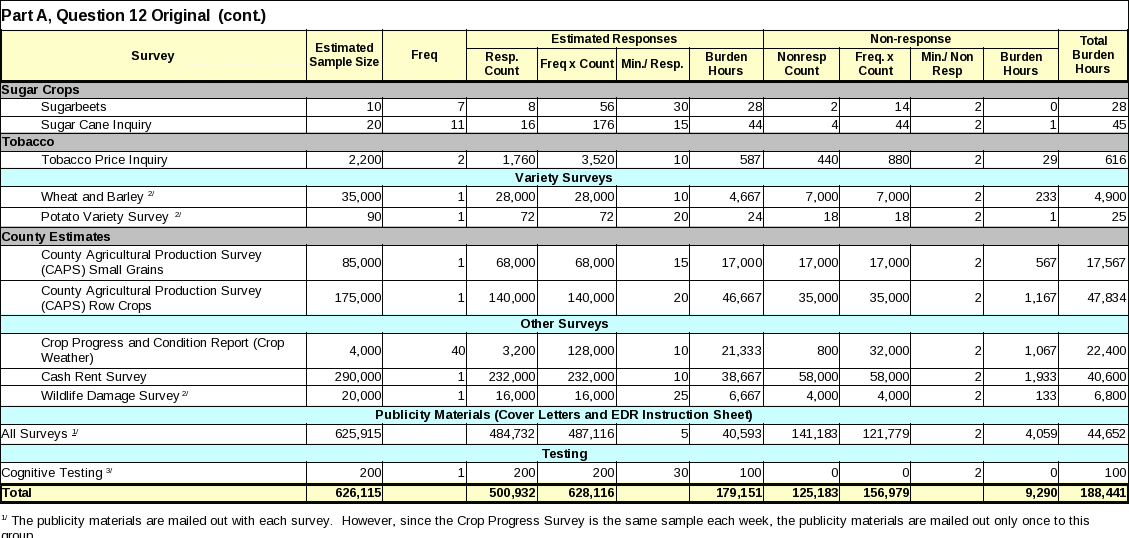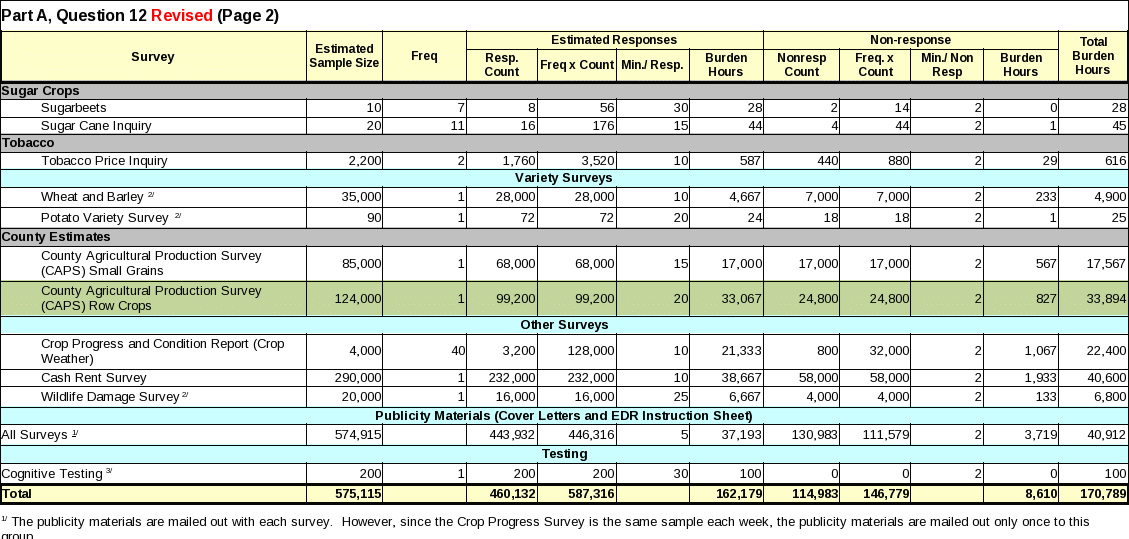Supplemental Supporting Statement A for County Estimates Substantive Change Request
0002-fieldcrops-2019-SSA - Adjusted for County Estimates - 11-07-2019.docx
Field Crops Production - Non-Substantive Change Request for Hawaii Seed Crops
Supplemental Supporting Statement A for County Estimates Substantive Change Request
OMB: 0535-0002
1 SUPPLEMENTAL SUPPORTING STATEMENT Part A
FIELD CROPS PRODUCTION
Substantive Change
OMB No. 0535-0002
This substantive change is being submitted as a supplemental supporting statement to the Field Crops Production docket. This document identifies changes made to the County Agricultural Production Survey (CAPS) for crop years 2019, 2020, and 2021.
A. JUSTIFICATION
1. Circumstances making collection of information necessary.
NASS is requesting a substantive change to the County Agricultural Production Survey (CAPS) for crop years 2019, 2020, and 2021 (i.e., the duration of this clearance). Recently, NASS was informed by USDA’s Risk Management Agency (RMA) that they will no longer provide funding to support the County Estimates Program. Historically, RMA has provided substantial funds for the County Estimates Program; most recently they provided $825,000. This loss of funds necessitates a reduction to the County Estimates Program. After a thorough review of the entire County Estimates program and the known needs for NASS’s county level data, the following crops are proposed to be dropped from the County Estimates Program (starting with the 2019 crop year):
Dry Edible Beans
Flaxseed
Hay – Alfalfa and Other
Potatoes
Sugarbeets
Sugarcane
Sunflower – Non-Oil and Oil and
Tobacco
In addition, NASS will drop county estimates based on irrigated/non-irrigated practices. The approved annual sample size for the CAPS for row crops is approximately 175,000. Removing the above-mentioned crops and irrigated/non-irrigated practices will remove approximately 51,000 operations from the enumerated CAPS sample.
If dropping the above-mentioned row crops do not achieve a sufficient reduction in data collection costs, additional cuts to CAPS for small grains may be proposed to affect the 2020 and 2021 small grains crop years. If this is necessary, an additional change request will be issued in early 2020.
External Project Agreements:
In addition to the county estimates funded in NASS’s Federal appropriation, NASS collects some additional CAPS data under External Project Agreements (EPAs). These EPAs are funded by various state cooperators (such as State Departments of Agriculture) and fulfil needs for county-level data not covered under NASS’s Federal program. NASS expects to have the following EPAs in place for the 2019 crop year (row crops). This proposed change to the Federal CAPS program will not affect these agreements.
Montana: Dry Peas, Canola, Lentils, Alfalfa Seed, and Leaf Cutter Bees
North Dakota: Dry Peas, Canola, and Lentils
Delaware: Irrigated and Non – Irrigated Corn and Soybeans
Colorado, Kansas, Oklahoma, Texas, and Wyoming: Winter Wheat Varieties
2. How, by whom, and for what purpose information is to be used.
There are no changes to the long list of potential people who use the data collected by the small grain and row crop County Agricultural Production Surveys. After careful evaluation of Federal programs, the determination of which commodities to remove from the County Estimates survey was made. NASS will continue to produce US and State level estimates for all the commodities that have historically been in our publications. The only changes will be to county level data.
3. Use of improved information technology.
The CAPS that are being impacted by this substantive change have already been converted over to electronic data reporting (EDR). Therefore the EDR instruments will be updated to reflect these changes. Overall the percent of questionnaires that are completed by internet remains at 26 percent.
4. Efforts to identify duplication.
There are no changes from the original approval related to duplication reduction.
5. Methods to minimize burden of small businesses.
Information requested on surveys included in this docket can be provided with a minimum of difficulty by respondents, generally without having to consult their record books.
Out of the revised, estimated sample size of 124,000 for the row crop CAPS, 100 percent are estimated to be classified as small operations. Overall, out of the total sample size of 575,115, an estimated 488,800 or approximately 85 percent.
6. Consequence if information collection were less frequent.
There are no changes to the frequency of these surveys that was originally approved.
Special circumstances.
No special circumstances are associated with this information collection.
Federal register notice and consultation with outside persons.
Not applicable.
Payments or gifts to respondents.
No payments or gifts will be given to respondents.
Confidentiality provided to respondents.
Confidentiality will be provided to respondents in accordance with the Confidential Information Protection and Statistical Efficiency Act (CIPSEA) of 2002. All confidentially protections that are applied to all products released from these surveys will remain the same as originally approved.
Questions of a sensitive nature.
No questions of sensitive nature will be asked.
12. Provide estimates of the hour burden of the collection of information. The statement should indicate the number of respondents, frequency of response, annual hour burden, and an explanation of how the burden was estimated.
The following table contains the adjusted, estimated annual burden hours for this group of surveys. Cost to the public for completing the questionnaire is assumed to be comparable to the hourly rate of those requesting the data. Average annual reporting time of 170,789 hours is multiplied by $36.84 per hour for a total annual cost to the public of $6,291,866.76.
NASS uses the Bureau of Labor Statistics’ Occupational Employment Statistics (most recently published on March 29, 2019 for the previous May) to estimate an hourly wage for the burden cost. The May 2018 mean wage for bookkeepers was $20.25. The mean wage for farm managers was $38.43. The mean wage for farm supervisors was $24.42. The mean wage of the three is $27.70. To calculate the fully loaded wage rate (includes allowances for Social Security, insurance, etc.) NASS will add 33% for a total of $36.84 per hour.
Average completion time per questionnaire is based on time required for other surveys of similar length. Calculation of burden hours is shown in the table below. Estimated response counts are based on an 80% target response rate and minutes per response shown are the average times for all questionnaires used for the commodity.



13. Provide an estimate of the total annual cost burden to respondents or record keepers resulting from the collection of information.
There is no cost burden to respondents.
14. Annualized costs to federal government.
The change to the total annual cost or $12.0 million for the field crop programs will be a reduction of $825,000 for a new total of $11.2 million.
15. Reasons for changes in burden.
The revised total burden of 170,789 hours is down 17,680 hours from the current inventory of 188,469 hours. The decrease is due to reduction in CAPS for row crops.

16. Tabulation, analysis, and publication plans.
The only planned changes to publications are due to changes in the CAPS for row crops. County level data will not be summarized or published for the commodities listed in Item 1 above. Any state(s) that only had county estimates published, historically, for the commodities listed in Item 1 will be dropped from any of the county estimates publications. In addition, data for some smaller counties in some states may need to be suppressed due to confidentiality rules.
2020 Field Crops Production Surveys
(State and National Estimates will still be published according to the dates below.)
Survey |
Data Collection Period |
Publication |
|
Publication Name |
Release Date |
||
Alfalfa/Grass Seed |
Jan |
FO monthly release |
Feb - Mar |
Dry Beans |
Nov - Dec |
Annual Summary |
January |
Mint |
Nov |
Annual Summary |
January |
Oilseeds, Special |
Nov - Dec |
Annual Summary |
January |
Potatoes |
May, Aug, Sept, Nov & Dec |
Crop Production |
12th of month |
Potatoes |
Sep 20 |
||
Sugar beets |
Mar, Jun, Aug-Nov |
Crop Production |
12th of month
|
Sugarcane |
Jun; Aug-Mar |
Crop Production |
12th of month
|
Sunflower, Non-oil |
Mar, Jun, Dec |
Prospective Planting and Acreage
|
Annual
|
Sweet potatoes |
Feb, Jun |
Ag Prices |
End of month |
Tobacco - Price |
Feb & May |
Ag Prices |
End of month |
Variety Surveys: Barley |
Jan |
Variety Summaries |
Feb |
Crop Progress |
weekly Apr-Nov |
Crop Progress |
Mondays |
All NASS publications are available on-line immediately after release at:
https://www.nass.usda.gov/Publications/.
Once there, you can select publications by date, subject, keyword, title, release date, etc. Here are links to some of the reports covered by this docket renewal.
National Crop Progress and Condition Reports:
https://usda.mannlib.cornell.edu/MannUsda/viewDocumentInfo.do?documentID=1048.
Crop Production Releases:
https://usda.mannlib.cornell.edu/MannUsda/viewDocumentInfo.do?documentID=1046.
Potatoes Annual Summaries:
https://usda.mannlib.cornell.edu/MannUsda/viewDocumentInfo.do?documentID=1123.
Agricultural Land Values:
https://usda.mannlib.cornell.edu/MannUsda/viewDocumentInfo.do?documentID=1446
Statistics by State for specialty commodities:
https://www.nass.usda.gov/Statistics_by_State/index.php
17. Request for approval of non-display of expiration date.
There is no request for approval of non-display of the expiration date.
18. Exceptions to certification statement.
There are no exceptions to the certification statement.
November 2019
| File Type | application/vnd.openxmlformats-officedocument.wordprocessingml.document |
| Author | hancda |
| File Modified | 0000-00-00 |
| File Created | 2022-01-25 |
© 2025 OMB.report | Privacy Policy